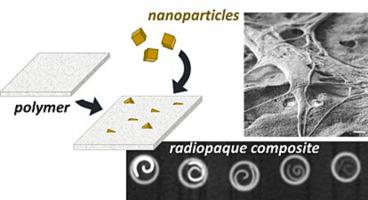Nanomedicine: Nanotechnology, Biology and Medicine ( IF 5.4 ) Pub Date : 2023-06-14 , DOI: 10.1016/j.nano.2023.102692 Kendell M Pawelec 1 , Jeremy M L Hix 2 , Erik M Shapiro 1

|
Repairing peripheral nerve injuries remains a challenge, even with use of auxiliary implantable biomaterial conduits. After implantation the location or function of polymeric devices cannot be assessed via clinical imaging modalities. Adding nanoparticle contrast agents into polymers can introduce radiopacity enabling imaging using computed tomography. Radiopacity must be balanced with changes in material properties impacting device function. In this study radiopaque composites were made from polycaprolactone and poly(lactide-co-glycolide) 50:50 and 85:15 with 0–40 wt% tantalum oxide (TaOx) nanoparticles. To achieve radiopacity, ≥5 wt% TaOx was required, with ≥20 wt% TaOx reducing mechanical properties and causing nanoscale surface roughness. Composite films facilitated nerve regeneration in an in vitro co-culture of adult glia and neurons, measured by markers for myelination. The ability of radiopaque films to support regeneration was driven by the properties of the polymer, with 5–20 wt% TaOx balancing imaging functionality with biological response and proving that in situ monitoring is feasible.
中文翻译:

原代神经元和神经胶质细胞在不透射线的可植入生物材料上的功能附着用于神经修复
即使使用辅助可植入生物材料导管,修复周围神经损伤仍然是一个挑战。植入后,聚合物装置的位置或功能无法通过临床成像方式进行评估。将纳米粒子造影剂添加到聚合物中可以引入射线不透性,从而能够使用计算机断层扫描进行成像。射线不透性必须与影响设备功能的材料特性的变化相平衡。在这项研究中,不透射线复合材料由聚己内酯和丙交酯-乙交酯共聚物(50:50 和 85:15)以及 0-40 wt%氧化钽 (TaO x ) 纳米颗粒制成。为了实现射线不透性,需要≥5 wt% TaO x ,≥20 wt% TaO x会降低机械性能并导致纳米级表面粗糙度。通过髓鞘形成标记物测量,复合膜促进了成年神经胶质细胞和神经元的体外共培养中的神经再生。不透射线薄膜支持再生的能力是由聚合物的特性驱动的,5-20 wt%的TaO x平衡了成像功能与生物反应,并证明了原位监测是可行的。



























 京公网安备 11010802027423号
京公网安备 11010802027423号